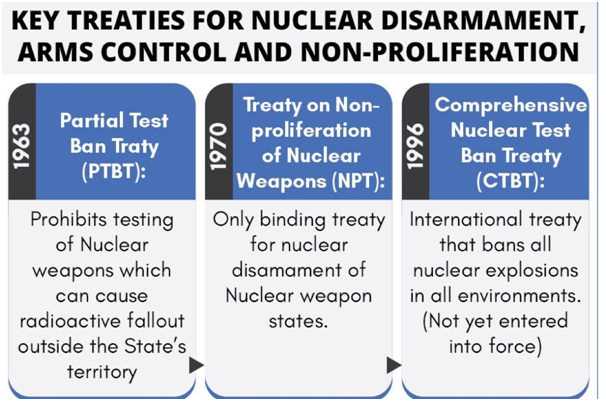Non- Proliferation Treaty
What is NPT?
- The NPT was negotiated during the 1960s to reconcile three competing objectives:
- controlling the further spread of nuclear weapons beyond the P-5 countries that had already tested
- committing to negotiating reductions of nuclear arsenals leading to their elimination
- sharing the benefits of peaceful applications of nuclear science and technology.
- The first was strongly supported by the nuclear-haves; the latter two were demands made by the nuclear have-nots.
Evolution of the Treaty
- Over the Years, After the end of the Cold War and the break-up of the U.S.S.R. in 1991, non-proliferation remained a shared priority for the major powers, and the International Atomic Energy Agency, set up originally to promote international co-operation became better known as the non-proliferation watchdog.
- In the review year of 2022, one major difference from other years was that, In the past, the divergences were over Iran, Israel, and West Asia, or between the nuclear haves and nuclear have-nots.
- The three depositary states (the United States, the United Kingdom, and the U.S.S.R./Russia) were always on the same page.
- In 2022 it pitched Russia against the West; it was the inability to find language to address the nuclear safety crisis at the Zaporizhzhia nuclear power plant in Ukraine, under Russian occupation since March, that ultimately led to the failure.
- In 2019, the S. notified Russia of its decision to quit the 1987 Intermediate-Range Nuclear Forces (INF) Treaty that obliged both countries to get rid of all ground-launched missiles with a range of 500-5,500 km.
- The U.S. blamed Russia for cheating on its obligations and pointed out that China’s missile developments created new security threats that needed to be addressed.
- The only surviving arms control treaty between Russia and the U.S. is the New START Treaty which imposes a ceiling on operational strategic nuclear weapons of 700 launchers and 1,550 warheads each. It expires in 2026 and there are no signs of any follow-on discussions.
- Russia recently suspended the NEW START Treaty which further blemishes the future of the pact.
Nuclear Modernisation
- The U.S.’s 30-year nuclear modernisation programme, intended to provide ‘credible deterrence against regional aggression’ is already underway. This has been used to justify developing and deploying more usable low-yield nuclear weapons.
- Russia (and China too) is developing hypersonic delivery systems that evade missile defences as well as larger missiles that do not need to travel over the Arctic.
- Last year, satellite imagery over China revealed that at least three new missile storage sites are being developed. Analysts suggest that China may be on track to expand its arsenal from current levels of approximately 350 warheads to over 1,000 by 2030.
- Developments in space and cyber domains are blurring the line between conventional and nuclear weapons, leading to nuclear entanglement and rendering command and control systems vulnerable.
- When the nuclear have-nots suggested a universal condemnation of all threats of nuclear use, all five nuclear-haves joined together to resist such moves. This reflects an emerging divide.
Other Measures towards Nuclear free world
- The nuclear have-nots successfully negotiated a Treaty on the Prohibition of nuclear weapons (TPNW, also called Ban Treaty) in 2017 that entered into force in January 2021.
- All 86 signatories are nuclear have-nots and parties to the NPT. The TPNW creates a new legal instrument.
- The TPNW states committed to pushing for ‘stigmatizing and de-legitimizing’ nuclear weapons, condemning all nuclear threats and ‘building a robust global peremptory norm against them’.
- The Comprehensive Test Ban Treaty (CTBT) was concluded in 1996 but has yet to formally enter into force because two major powers, the U.S. and China, have yet to ratify it.
Therefore, nobody wants a breakdown of the NPT but sustaining it requires facing up to today’s political realities. The rivalries in a multipolar nuclear world create new challenges, different from what the world faced in a bipolar era of the 1960s when the NPT was concluded. Without addressing the new challenges, the NPT will weaken and with it, the taboo against nuclear weapons that has been held since 1945.
| Practice Question
1. The Ukraine Russia war has further derailed the dream of a Nuclear Weapon free world. Elaborate. |




